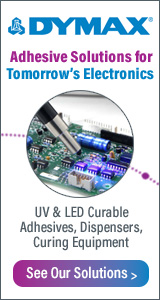|

|
|
| Ask the Experts | |||||||
|
|||||||
|
October 20, 2025 - Updated June 23, 2020 - Originally Posted Step Stencil Squeegee AngleIf you have step stencil, what angle should we use for the squeegee when printing solder paste, and what other parameters are important? P.P. |
|||||||
| Expert Panel Responses | |||||||
|
We recommend using the standard 60 degree squeegee blade angle for most applications. It is beneficial to slow the print speed to give the blade more time during printing to conform around / into the step. A general starting point for print speed would be 20-30 mm/sec. The blade pressure should be set as normal for the solder paste, e.g. use just enough pressure to clean the paste off of the stencil. It is a good idea to contact your solder paste supplier for more specific recommendations.
Field Applications FCT Assembly Tony has worked in the electronics industry since 1994. He worked as a process engineer at a circuit board manufacturer for 5 years. Since 1999, Tony has worked for FCT Companies as a laboratory manager, facility manager, and most recently a field application engineer. He has extensive experience doing research and development, quality control, and technical service with products used to manufacture and assemble printed circuit boards. He holds B.S. and M.B.S. degrees in Chemistry.
If using a Stainless Steel squeegee blade then a 45° angle should work. If using a polymer squeegee blade several factors are to be considered. However if using a durometer of 65 and the polymer blade is a flat edge I would start with a 35°. If the blade is a diamond cut, then a 0° to 8° should be tested. Please note: There are unknown factors at the moment; as in solder paste mesh type, squeegee pressures, printing speeds and squeegee length, stencil thicknesses, stencil snap release speeds and distances.
Engineering Manager Circuit Technology Center, Inc. Manufacturing Engineer of 20+ years. Involved in Industries relating to all sectors of defense, Commercial product Industries, RF - Microwave and Semiconductor industries. Vast knowledge and experience relating Mil-STD’s, IPC-STD’s, EAI-STD’s, GEIA-STD’s, J-STD’s and MIL-PRF-STD’s.
Angle of squeegee for stepped is exactly the same as normal, more important is not to over pressurize the squeegee blade (1Kg every 50mm of squeegee length) and don't go too fast T4 powder around 25mm/s speed.
Technical Sales Manager BLT Circuit Services Ltd Greg York has over thirty two years of service in Electronics industry. York has installed over 600 Lead Free Lines in Europe with Solder and flux systems as well as Technical Support on SMT lines and trouble shooting.
The purpose of the step-up or step-down stencil is to achieve maximum solder deposition in the modified area. As with a regular stencil you should also consider squeegee pressure and speed. Most of my work has been with a laser-etched stencil and a plain metal squeegee at an angle of 60 degrees. For a step-up and down stencil I've read a couple of white papers that recommend 45 degree squeegee angle and a metal squeegee that has some type of coating along its edge that will provide a better adaptability to the stencil surface.
Senior Manufacturing Engineer Northrop Grumman Edithel is a chemical engineer with 20 year experience in manufacturing & process development for electronic contract manufacturers in US as well as some major OEM's. Involved in SMT, Reflow, Wave and other assembly operations entailing conformal coating and robotics.
I would not change the angle of the squeegees you are using now. Monitor the pressure, speed and cleanliness of the stencil after paste application.
Engineering and Operations Management Independent Consultant Georgian Simion is an independent consultant with 20+ years in electronics manufacturing engineering and operations.
Contact me at georgiansimion@yahoo.com. Reader Comment
When using stepped stencils, whether they are stepped up or down, I would recommend printing with 80 durometer polyurethane squeegee blades. The 80 durometer blade will contour to the stepped area, allowing it to wipe the stencil surface clean, while not being too soft or too hard. No need to change the angle, as the 60 degree angle will keep the solder paste rolling as it should, whereas a 45 degree angle may drag the paste, and it won't deposit properly.
Bob Enterkin, High-Tech Conversions
|
|||||||
| Submit A Comment | |||||||
|
Comments are reviewed prior to posting. You must include your full name to have your comments posted. We will not post your email address. |
|
Free Newsletter Subscription
Circuitnet is built for professionals who bear the responsibility of looking ahead, imagining the future, and preparing for it. Insert Your Email Address |
|

|






